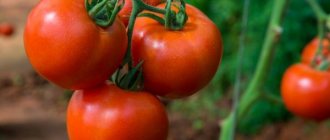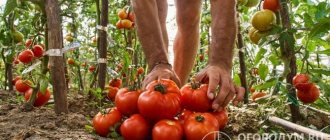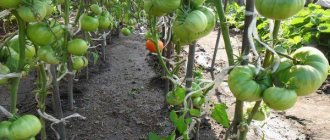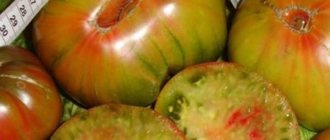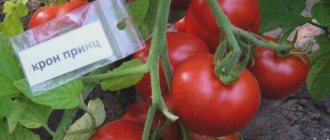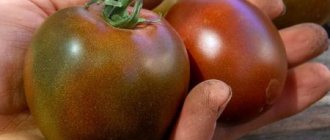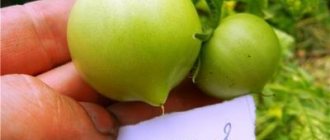How was a dark-fruited tomato able to surpass red and pink varieties and become so in demand throughout the country? It’s very simple: Black Prince has excellent taste criteria, excellent marketability, and high productivity. It will become a decoration for garden beds and a useful vegetable in the diet. It is no secret that black fruits hold the record for lycopene, a component that reduces the risk of cancer and cardiovascular diseases.
| Height | Landing location | Ripening time | Fruit color | Fruit size | Origin | Fruit shape |
| Tall | Greenhouse, Open ground | Mid-season | Black | Average | Variety | Round |
Description and characteristics of the variety
Initially, a variety was bred that provided the basis for the first generation hybrids. In order not to make a mistake with your choice, you should carefully study in the instructions whether a tomato is a hybrid or a variety, since hybrid seeds are not suitable for planting.
Tomato Black Prince "Siberian" garden is a tall indeterminate plant.
The characteristics of bushes include the following:
- trunk height 1.5-2 m;
- stormy vegetation;
- semi-spreading;
- moderate branching;
- bristly trunks;
- simple inflorescences;
- 6-8 tomatoes are formed on fruitful clusters;
- the leaves are ordinary, medium size, dark green;
- the root reaches 50 cm in diameter;
- the first ovary is formed after the 9th leaf.
Tomato Black Prince is a hybrid or not - you can find out from the specific manufacturer from the description on the package.
The hybrid line is more hardy and persistent. When formed into 1-2 stems and removing excess flowers from the cluster, it bears large fruits.
The Black Prince “Gavrish” tomato comes from the garden to the table from mid-July until the end of September. It is mid-season in terms of ripening. Fruiting begins 115-125 days after germination.
The Black Prince tomato can reach a height of more than 2 m; the tops must be pinched. Regular feeding is required, at least once every 10 days.
Tomato Black Prince “Russian vegetable garden” has the following typical characteristics of tomatoes:
- average weight 100-300 g;
- large fruits weigh 500-600 g;
- diameter 7-8 cm;
- round shape;
- the color is ash-pink-dark with characteristic purple shoulders;
- the flesh is fleshy, oily at the break, moderately juicy;
- the skin is strong and the fruits are well transported;
- dry matter level 5-6%.
The taste is harmonious - sourness and sweetness combine pleasantly.
Country of origin, year of registration
The variety originated in China. In Russia, the originator was NPK LTD. Entry into the State Register occurred in 2000.
Growing regions
The variety is intended for planting throughout the country:
- in the south in open beds;
- in the north in heated shelters;
- in the central regions in standard greenhouses.
Method of use
Recommended for fresh consumption. Many people like it due to the sweetness of the fruit.
Widely used in a variety of dishes:
- slices and salads;
- ketchups and sauces;
- dressings and pastes;
- canning and pickling.
It is considered a useful addition to meat, fish, and side dishes.
Planting and care
Strong seedlings and proper agricultural technology allow you to grow a good harvest and tasty fruits. Black Prince tomatoes are not too capricious to care for, but the plants cannot be left without care. It is especially important to carry out the formation of the bush, regular dosed watering, and fertilizing.
Growing seedlings
Approximately 60 days before planting tomatoes, seeds are sown:
- Tomato seeds are placed in grooves about 1 cm deep every 1.5-2 cm.
- Cover with film or glass and keep at a temperature of 22-25 °C. Ventilate and check humidity daily.
- As soon as the first tomatoes hatch, the seedling container is placed in a cool, bright room with a temperature of about 14-16 °C. This is necessary so that the seedlings do not stretch out.
- After a week, the tomatoes are moved to a warm room (20-22 °C) and illuminated for up to 12-14 hours a day.
- Tomatoes peak at the stage of 2-3 true leaves.
- After 10-14 days, they begin to feed with complex fertilizers with increased doses of nitrogen.
- A week before planting the seedlings, the tomatoes are hardened off.
Landing
For tomatoes of this variety in open ground, the recommended planting pattern is 40 × 70 cm. When formed into 1 trunk, compaction is possible, but this should only be done in greenhouses.
In the garden for tomatoes, choose an open sunny place with rich organic matter, neutral or slightly acidic soil. If the bed has not been fertilized since the fall before digging, fertilizing is applied directly to the hole. Mix in equal parts:
- complex fertilizer;
- lime;
- tobacco dust;
- dry mustard.
This will be enough for the first time, and will protect the bush from some diseases and pests. The tomatoes are placed in the center of the hole so that the lower true leaves are slightly above ground level, covered with soil, compacted, and watered.
Important! If the seedlings have stretched out and require deepening, the lower leaves are removed in advance so that the damaged areas have time to cork before planting the tomatoes and do not become infected.
Watering, fertilizing
Watering tomatoes should be even and moderate. If periods of drought alternate with high humidity, the fruits will crack.
In the first half of growth, tomatoes are in the vegetative phase of development and require complex fertilizing with a predominance of nitrogen. As soon as they grow green mass and a second flower cluster appears from the leaf axil, the tomatoes are transferred to the generative stage. During this period, the doses of potassium and phosphorus in fertilizing are increased, and very little nitrogen is given.
Foliar treatments with complex fertilizers and chelates are useful for tomatoes. Plants absorb microelements better through the leaves, and with this method of fertilizing, nitrogen is quickly removed, and nitrates do not have time to accumulate in the fruits.
Bush formation, pinching
How to form a bush depends on whether the variety is grown in a greenhouse or in an open garden bed:
- in the garden, it is recommended to plant tomatoes in 2-3 trunks, always tying them to a support;
- in greenhouses it is better to leave 1 shoot - the variety is not the most productive, and this is the only way to save space.
Whether it is necessary to take stepson is not a question for indeterminate tomatoes - all side shoots are mercilessly broken off or cut off as soon as they reach a size of 5 mm. If the variety is grown in 2-3 trunks, 1 shoot is left under the first fruit cluster, the second - below one of the subsequent ones.
Important! The leaves under the tomatoes that have begun to fill are removed. This should be done regularly, removing 1-2 plates from the bush per week. If you cut off several leaves at once, the tomato will experience shock.
Black Prince tomatoes are indeterminate - with unlimited growth. In greenhouses this is not a problem - high varieties are needed there in order to produce the maximum yield in a minimum area. It is important to pinch the tops early to limit growth and stop the formation of new flower clusters about 45 days before the end of the season. They still won’t have time to ripen, they will only consume nutrients.
Features of cultivation and storage
The result is excellent when growing seedlings and then transferring them to stationary beds.
The optimal time for transplantation is the age of the bushes 50-60 days.
The beds are chosen after zucchini, carrots, salads and green crops. To increase fertility in the fall or spring, add:
- compost;
- superphosphate;
- potassium sulfate;
- saltpeter
The beds are treated with Bordeaux mixture or 1% Fitosporin 2 weeks before planting to disinfect the soil from pathogens.
How to plant correctly:
- Place the holes at a distance of 50-60 cm.
- No more than 3 bushes should fit per 1 m2.
- The distance between rows is 50-60 cm.
- The location is selected in a greenhouse or near trellises.
Tomato Black Prince: reviews of gardeners who planted
Tomatoes Black Prince: photo of variety
- Maria, 57 years old, Rostov: “I have a Black Prince tomato - this is one of my favorite varieties of tomatoes, I have been planting it for many years. The fruits are large, I use them in adjika and salads. In the winter cold, I cannot be happier with the yield of the Black Prince tomato. Tasty and nutritious!”
- Lyudmila Grigorieva, 36 years old, Kursk region: “My two little sons are involved with me in growing Black Prince tomatoes. They help me and dig around the site. After all, even children can handle this variety. In my case, this is in the literal sense! We often eat straight from the garden, and I have peace of mind because I don’t add chemicals. Black Prince tomatoes taste sweet and very beautiful.”
- Nikolaev Ruslan, 63 years old, Oryol region: “I am growing Black Prince tomatoes on my plot. It looks solid and requires little maintenance. And the harvest is usually not small. I collect a bucket a day. They don’t take up much space, although the Black Prince tomatoes are large and enough for my entire large family.
Tomato Black Prince: video about the variety
Description of the variety
The Black Prince tomato stands out among its “competitors” with many remarkable properties.
Advantages
A significant characteristic of the Black Prince variety is a combination of several valuable characteristics: large fruit, exotic appearance and taste, dietary benefits, unpretentiousness.
Fruit
The weight of one tomato is at least 110 g, most weigh 150-170 g, the first clusters often weigh 250-450 g. The shape is rounded-flat, the ribbing is moderate.
The surface color of the ripe fruits of the Black Prince is, of course, not black, but richly dark, chocolate-burgundy with a purple tone. The skin is thin, smooth, and shiny.
The pulp has a complex color, shimmering in shades of brown, greenish, burgundy, and orange. The consistency is not too dense, balanced in meatiness and juiciness.
Taste and benefits
The Black Prince tomato has a rich, slightly spicy taste. This is due to a special combination of sugary substances, organic acids and other bioactive compounds. Not all people like the original taste and color of black-fruited tomatoes, but they also have many fans.
Chokeberry tomatoes are very beneficial for human health because they contain large amounts of anthocyanins. These biologically active compounds are similar to vitamins. They stimulate the immune system, help cope with inflammation and cancerous degeneration of cells, inhibit aging, and help preserve vision. Modern scientific research has shown that there is a vital need to eat those plant foods that are rich in anthocyanins.
In addition to dark anthocyanins, Black Prince has all the benefits of tomato as a vegetable. It is a rich source of lycopene and ascorbic acid.
Interesting!
Ascorbic acid is highly destroyed by heat treatment, but lycopene is heat-resistant.
Black Prince tomatoes are a truly healing food. Conditional harm is possible only in the presence of individual allergic reactions. It is also not recommended to eat large quantities of unripe tomatoes: they contain a lot of solanine, a rather toxic alkaloid characteristic of the Solanaceae family.
See also: “Tomato leaves turn yellow in a greenhouse: causes and methods of control.”
Culinary purpose
Black Prince is a salad tomato. Fresh salads made from black tomatoes are especially useful, and the Black Prince variety is one of the most delicious. Mixtures with varieties of other colors (red, orange, yellow, pink) are varied in their vitamin composition. In addition to the obvious benefits, such combinations are original and beautiful.
The fruits of the Black Prince are not very suitable for whole-fruit pickling and preservation. But they are appropriate in salad preparations, especially when laid in multi-colored layers. They are also suitable for the production of ketchup, lecho, and horseradish (“horseradish”).
On a note!
The Black Prince tomato produces a high percentage of juice yield. The product is original, sweetish-spicy, with fruity notes.
Return of the harvest
Black Prince is a mid-season variety; it begins to ripen 113-120 days after the start of the growing season. Type of growth – indeterminate (long-term). Flower clusters are formed quite early - after the formation of 7-9 leaves. Tall plants (200 cm is not the limit) are potentially aimed at solid returns. The potential yield of Black Prince tomatoes is 5 kg per bush. Actual harvests depend on weather conditions and the level of agricultural technology.
Endurance
The variety is universal in terms of planting location - suitable for both greenhouses and street beds, including in the Middle Zone and Siberia. Plants successfully tolerate contrasts in temperature and humidity. Black Prince tomatoes have been popular for decades for good reason - they have developed good resistance to diseases, even to late blight: sometimes the foliage is affected, but the disease rarely affects the fruits.
You need to know this!
The Black Prince tomato is a resistant variety; you can independently obtain seeds from it for annual sowing.
Flaws
It cannot be said that the Black Prince tomato has significant disadvantages. You just need to take into account its features.
- The fruits are not intended for whole-fruit canning; ripe ones are not stored for a long time, and are not very transportable.
- During the ripening process, tomatoes sometimes resemble those affected by late blight; They retain a dark green spot in the area where the stalk attaches for a long time.
- The internodes are long, the distance between the racemes is 3 leaves.
- Indeterminate bushes need constant attention (re-tying, attaching brushes, pinching).
- The nutritional needs of plants are very high.
- When growing in greenhouses, it is necessary to organize active ventilation and protection against infections.
Rules for caring for seedlings
Tomato seedlings grow normally at an air temperature of 22-25 °C. Water it only at the roots in the first half of the day. In cloudy weather, turn on a fluorescent lamp (phytolamp).
Feeding is carried out twice:
- the first in the phase of the first 2 leaves;
- the second after the formation of the seventh.
They use liquid complex fertilizers for tomatoes: “Malyshok”, “Multiflor Aqua”, “Zdraven”.
Picking
Tomatoes tolerate pickling well. It stimulates root growth. Before planting in a permanent place, seedlings can be picked several times, transplanted into larger containers. The seedlings are planted for the first time after the appearance of the 2nd true leaf.
On the eve of picking, the seedlings are well watered. The seedlings are transplanted into separate containers along with a small lump of earth. They are buried down to the cotyledons and watered well. After several days of adaptation, the seedlings begin to grow.
Transplantation into open ground
The timing of planting in open ground depends on the weather (May, early June). They are transplanted into greenhouses from mid-April. Before transplanting, seedlings are hardened off for at least a week. Reduce night temperature to 8 °C. Seedlings take root faster if they are planted in cloudy weather. The bushes are tall, so no more than 3-4 plants are planted per 1 m².


